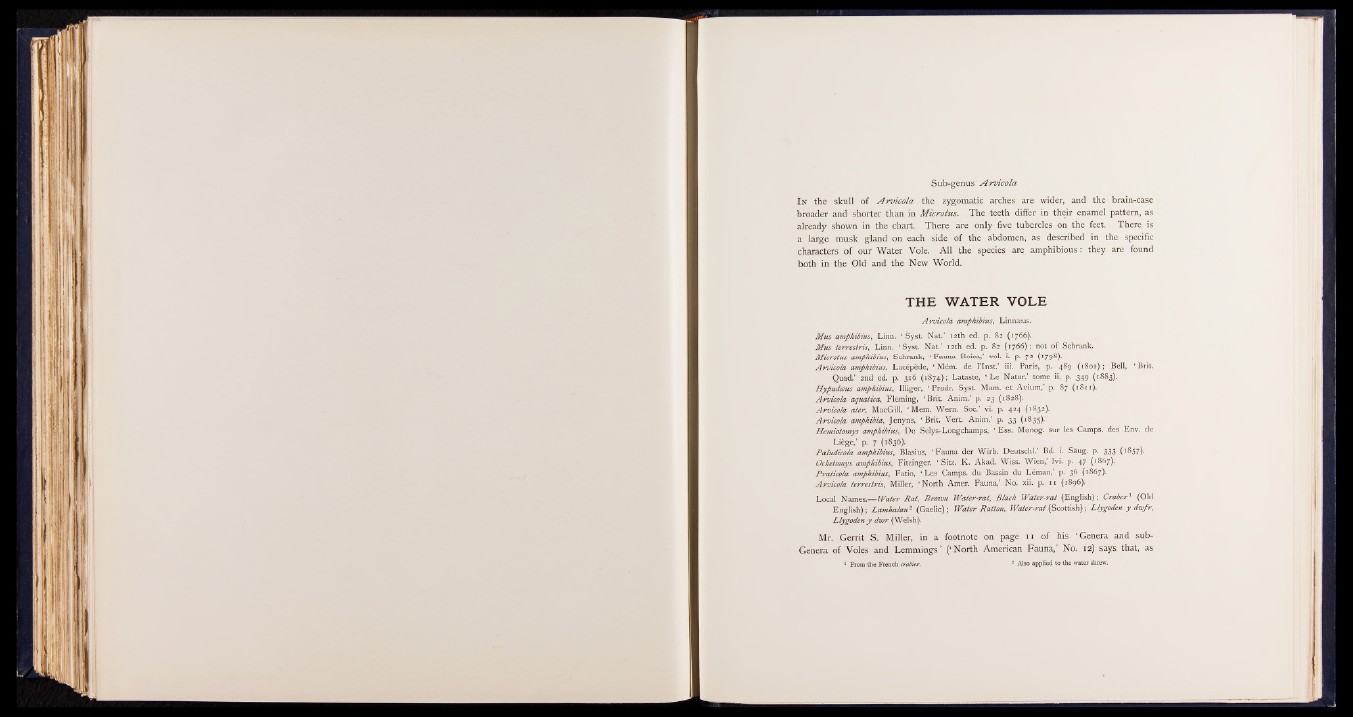
Sub-genus A rvico la
In the skull of A rvico la the zygomatic arches are wider, and the brain-case
broader and shorter than in Microtus. The teeth differ in their enamel pattern, as
already shown in the chart. There are only five tubercles on the feet. There is
a large musk gland on each side of the abdomen, as described in the specific
characters of our Water Vole. All the species are amphibious: they are found
both in the Old and the New World.
THE WATER VOLE
A rvicola antphibius, Linnaeus.
Mus amphibius, Linn. ‘ Syst. Nat.’ 12th ed. p. 82 (1766).
Mus terrestris, Linn. ‘ Syst. Nat.’ 12th ed. p. 82 (1766); not of Schrank.
Microtus antphibius, Schrank, ‘ Fauna Boica,’ vol. i. p. 72 (1798).
A rvicola amphibius, Lacépède, ‘ Mém. de l'Inst.’ iii. Paris, p. 489 (1801) ; Bell, ‘ Brit.
Quad.’ 2nd ed. p. 316 (1874); Lataste, ‘ Le Natur.’ tome ii. p. 349 (1883).
Hypudatts amphibius, Illiger, ‘ Prodr. Syst. Mam. et Avium,’ 'p.' 87 (1811).
A rvicola aquatica, Fleming, ‘ Brit. Anim.’ p. 23 (1828).
A rvicola ater, MacGill, ‘Mem. Wern. Sop.’ vi. p. 424 (1832).
A rvicola amphibia, Jenyns, ‘ Brit. Vert. Anim.’ p. 33 (1835)-
Hemiotomys amphibius, De Selys-Longchamps, ‘ Ess. Monog. sur les Camps, des Env. de
Liège,’ p. 7 (1836).
Paludicola amphihius, Blasius, ‘ Fauna der Wirb. Deutschl.’ Bd. i. Säug. p. 333 (1857)-
Ochetomys amphibius, Fitzinger, ‘ Sitz. K. Akad. Wiss. Wien, Ivi. p. 47 (1867)-
Praticola amphibius, Fatio, ‘ Les Camps, du Bassin du Léman, p. 36 (1867)-
A rvicola terrestris, Miller, ‘North Amer. Fauna,’ No. xii. p. 11 (1896).
Local N âmes.—Water Rat, Brown Water-rat, Black Water-rat (English); Craber1 (Old
English); Lamhalan2 (Gaelic); Water Ratton, Water-rat (Scottish); Llygoden y dwfr,
Llygoden y dw r (Welsh).
Mr. Gerrit S. Miller, in a footnote on page 1 1 of his ‘ Genera and sub-
Genera of Voles and Lemmings’ (‘ North American Fauna,’ No. 12) says that, as
s Also applied From the French crobier. to the water shrew.